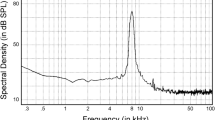Abstract.
While searching for prey in open spaces, Eptesicus fuscus emits long-duration, downward frequency-modulated calls which cover a frequency band of about 28–22 kHz. In the ascending auditory pathways of E. fuscus, neurons tuned to these search call frequencies are characterised by a remarkably high frequency selectivity and very sensitive absolute thresholds. We investigated whether this narrow tuning is reflected in an exceptional psychoacoustic frequency discrimination ability. The average frequency difference limen of E. fuscus at search call frequencies determined in a two-alternative, forced-choice experiment amounted to about 420 Hz, corresponding to a Weber ratio of 0.017. This value is similar to those found in non-echolocating mammals, and an order of magnitude larger than the frequency difference limens of bats emitting constant-frequency call components. We discuss these differences in frequency difference limen, and relate them to different echolocation strategies.
Similar content being viewed by others
Author information
Authors and Affiliations
Additional information
Electronic Publication
Rights and permissions
About this article
Cite this article
von Stebut, B., Schmidt, S. Frequency discrimination threshold at search call frequencies in the echolocating bat, Eptesicus fuscus. J Comp Physiol A 187, 287–291 (2001). https://doi.org/10.1007/s003590100200
Accepted:
Issue Date:
DOI: https://doi.org/10.1007/s003590100200




